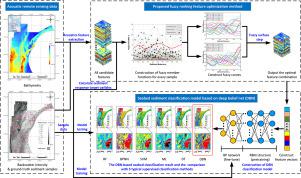Marine Geology ( IF 2.6 ) Pub Date : 2020-12-03 , DOI: 10.1016/j.margeo.2020.106390 Xiaodong Cui , Fanlin Yang , Xin Wang , Bo Ai , Yu Luo , Dan Ma

|
Accurate acquisition of information on seabed sediment distributions plays an important role in the construction of basic marine geographic databases. Although a multibeam echo-sounding system (MBES) can satisfy large-scale seafloor mapping with high precision and high resolution, the development of a consistent, stable, repeatable and validated seabed sediment classification method based on swath acoustic data is still in its infancy. To achieve accurate prediction and mapping of geographic seabed sediment information, this paper developed a deep learning model based on feature optimization. First, faced with high-dimensional features extracted from multibeam bathymetry and backscatter intensity measurement data, a fuzzy ranking (FR) feature optimization method was proposed. By combining the physical properties of actual sediment samples, the multidimensional features derived from terrain and intensity data are ranked and optimally selected according to the mean square error to eliminate redundant and irrelevant features. Second, the deep belief network (DBN) deep learning method was used to build a supervised seabed sediment classification model. The optimized features and actual sediment samples participate in model training, which further enhances the prediction ability of acoustic data to seabed sediments. Finally, to evaluate the performance of the DBN model, this experiment used large-scale multibeam survey data and ground-truth data (acquired by grabbers, core samplers, dredges, etc.) in the southern Irish Sea to achieve accurate prediction of 10 sediment types (slightly gravelly muddy sand, slightly gravelly sand, gravelly mud, gravelly muddy sand, gravelly sand, muddy sand, muddy sandy gravel, sand, sandy gravel and sandy mud). The experiment results show that by using the optimal feature combination based on FR, the overall classification accuracy and Kappa coefficient reached 86.20% and 0.834, respectively, which are significantly improved compared to the evaluation metrics of other feature selection methods. In addition, compared with the current five typical supervised classification methods (i.e., the random forests, BP neural network, support vector machine, maximum likelihood and decision trees methods), the proposed DBN classification model achieves a better performance, highlighting its application potential in seabed sediment detection and mapping.
中文翻译:

基于模糊排序特征优化的海床沉积物分类深度学习模型
准确获取有关海底沉积物分布的信息在基础海洋地理数据库的建设中起着重要作用。尽管多波束回波测深系统(MBES)可以满足高精度和高分辨率的大规模海底制图,但基于条幅声波数据的一致,稳定,可重复和经过验证的海底沉积物分类方法仍处于起步阶段。为了实现对海底沉积物地理信息的准确预测和测绘,本文建立了基于特征优化的深度学习模型。首先,针对从多波束测深和反散射强度测量数据中提取的高维特征,提出了一种模糊排序(FR)特征优化方法。通过结合实际沉积物样品的物理特性,对来自地形和强度数据的多维特征进行排序,并根据均方误差进行最佳选择,以消除多余和无关的特征。其次,使用深度信念网络(DBN)深度学习方法建立了有监督的海床沉积物分类模型。优化的特征和实际沉积物样本参与模型训练,这进一步增强了声学数据对海底沉积物的预测能力。最后,为了评估DBN模型的性能,该实验使用了爱尔兰南部海域的大规模多波束调查数据和地面真实数据(由抓斗,岩心采样器,挖泥机等采集)来准确预测10个沉积物类型(轻度砂砾状的泥沙,轻度砂砾状的泥沙,砂砾状的泥,砂砾状的泥沙,砂砾状的泥沙,泥泞的沙子,泥泞的沙砾,沙子,沙砾和沙泥)。实验结果表明,采用基于FR的最优特征组合,总体分类准确率和Kappa系数分别达到86.20%和0.834,与其他特征选择方法的评价指标相比有明显提高。此外,与目前的五种典型的监督分类方法(即随机森林,BP神经网络,支持向量机,最大似然法和决策树方法)相比,提出的DBN分类模型具有更好的性能,突出了其在数据挖掘中的应用潜力。海底沉积物检测和制图。总体分类精度和Kappa系数分别达到86.20%和0.834,与其他特征选择方法的评估指标相比有显着提高。此外,与目前的五种典型的监督分类方法(即随机森林,BP神经网络,支持向量机,最大似然法和决策树方法)相比,提出的DBN分类模型具有更好的性能,突出了其在数据挖掘中的应用潜力。海底沉积物检测和测绘。总体分类精度和Kappa系数分别达到86.20%和0.834,与其他特征选择方法的评估指标相比有显着提高。此外,与目前的五种典型的监督分类方法(即随机森林,BP神经网络,支持向量机,最大似然法和决策树方法)相比,提出的DBN分类模型具有更好的性能,突出了其在数据挖掘中的应用潜力。海底沉积物检测和测绘。










































 京公网安备 11010802027423号
京公网安备 11010802027423号